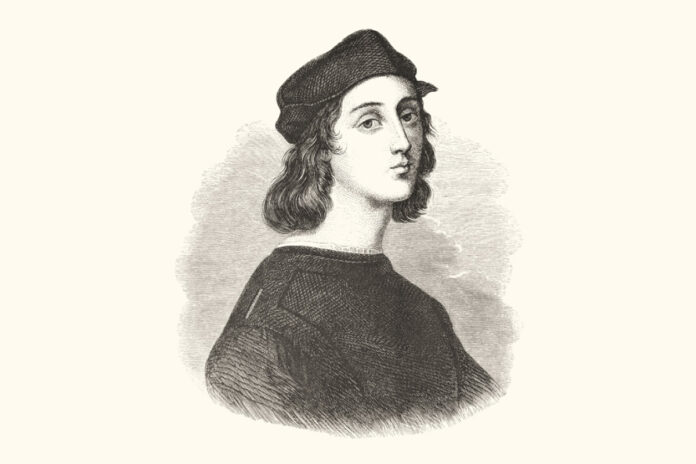Raphael Sanzio, often simply known as Raphael, is one of the most celebrated figures of the High Renaissance. His masterful paintings and architectural designs not only epitomize the ideals of Renaissance art but also continue to influence and inspire generations of artists. This article explores Raphael’s life, his significant works, and his lasting legacy.
Early Life and Education
Birth and Early Years
Raphael was born on April 6, 1483, in Urbino, a cultural hub in Italy during the Renaissance. His father, Giovanni Santi, was a court painter, which provided young Raphael with early exposure to art and the opportunity to observe and learn from a variety of accomplished artists.
Training and Influences
After his father’s death in 1494, Raphael moved to Perugia to apprentice under the painter Pietro Perugino. This apprenticeship had a profound impact on Raphael, who absorbed Perugino’s techniques and style. Early works like “The Marriage of the Virgin” (1504) reflect Perugino’s influence, particularly in the clarity and harmony of composition.
Rise to Prominence
Florence: The Cradle of the Renaissance
In 1504, Raphael moved to Florence, where he encountered the works of Leonardo da Vinci and Michelangelo. This period was crucial for Raphael’s development, as he assimilated Leonardo’s sfumato and anatomical precision, and Michelangelo’s dynamic figures and expressive forms. His Florentine period produced masterpieces such as “Madonna of the Goldfinch” and “The Entombment,” which showcase his evolving style and mastery of composition.
The Vatican: Patronage and Masterpieces
Raphael’s talents caught the attention of Pope Julius II, who invited him to Rome in 1508. Raphael’s work in the Vatican Palace, particularly the frescoes in the Stanza della Segnatura, solidified his reputation as one of the greatest artists of his time. The “School of Athens,” painted between 1509 and 1511, is a highlight of this period. This fresco, depicting an assembly of philosophers and scientists, exemplifies Raphael’s ability to harmonize complex compositions and convey intellectual grandeur.
Major Works and Contributions
The School of Athens
“The School of Athens” is one of Raphael’s most celebrated works. Located in the Vatican’s Apostolic Palace, this fresco represents the epitome of Renaissance humanism. It features prominent philosophers such as Plato and Aristotle at its center, surrounded by other classical thinkers. Raphael’s use of perspective and architectural elements creates a sense of depth and grandeur, making the fresco a masterpiece of composition and a tribute to classical knowledge.
The Sistine Madonna
Painted around 1512-1513, the “Sistine Madonna” is another of Raphael’s iconic works. This painting, commissioned by Pope Julius II for the church of San Sisto in Piacenza, features the Madonna holding the Christ child, flanked by Saint Sixtus and Saint Barbara. The ethereal quality of the figures, particularly the serene expression of the Madonna and the cherubic figures at the bottom, exemplifies Raphael’s skill in conveying divine grace and beauty.
The Transfiguration
“The Transfiguration,” completed posthumously by Raphael’s students, is considered his last great work. This painting, commissioned by Cardinal Giulio de’ Medici, showcases Raphael’s mature style and mastery of composition. The upper part depicts the transfigured Christ in a radiant cloud, while the lower section portrays the apostles attempting to heal a possessed boy. The juxtaposition of the divine and the earthly, along with the dramatic use of light and shadow, highlights Raphael’s ability to convey complex narratives with emotional intensity.
Architectural Achievements
St. Peter’s Basilica
In addition to his achievements in painting, Raphael made significant contributions to architecture. After the death of Donato Bramante in 1514, Raphael was appointed chief architect of St. Peter’s Basilica. His work on the basilica included the design of the new nave and the continuation of Bramante’s central plan. Raphael’s architectural style, characterized by harmony and proportion, influenced the development of Renaissance architecture and ensured that St. Peter’s Basilica remained one of the most significant architectural projects of the era.
The Villa Madama
Another notable architectural project by Raphael is the Villa Madama, commissioned by Cardinal Giulio de’ Medici. Although unfinished, the villa’s design showcases Raphael’s innovative approach to villa architecture, combining classical elements with contemporary Renaissance aesthetics. The use of decorative stucco and frescoes in the interior spaces reflects Raphael’s comprehensive vision of integrating art and architecture.
Raphael’s Influence and Legacy
Impact on Renaissance Art
Raphael’s influence on Renaissance art is profound and far-reaching. His harmonious compositions, masterful use of perspective, and ability to convey complex narratives set new standards in painting. Artists such as Giulio Romano and Perino del Vaga, who were part of Raphael’s workshop, continued to disseminate his style and techniques, ensuring his lasting impact on the art world.
Raphael’s Workshop
Raphael’s large workshop, which included numerous assistants and students, played a crucial role in the dissemination of his style. The collaborative nature of his workshop allowed for the production of numerous works, both major and minor, that bore Raphael’s stylistic influence. This workshop model not only ensured the completion of large projects but also served as a training ground for future generations of artists.
Raphael’s Drawings and Cartoons
Raphael’s preparatory drawings and cartoons also hold significant importance in the study of Renaissance art. His detailed sketches reveal his thought process and the meticulous planning that went into his compositions. The “Raphael Cartoons,” a series of designs for tapestries commissioned by Pope Leo X, showcase his ability to translate complex scenes into clear, powerful images that could be reproduced on a large scale.
Raphael’s Artistic Techniques
Use of Color and Light
Raphael’s use of color and light is one of the hallmarks of his style. He employed a vibrant palette and delicate gradations of tone to create a sense of depth and realism in his paintings. His mastery of chiaroscuro, the contrast between light and dark, adds a dramatic quality to his works, enhancing the emotional impact of his compositions.
Composition and Perspective
Raphael’s ability to organize complex scenes into harmonious compositions is unparalleled. He utilized linear perspective to create a sense of spatial depth, drawing the viewer’s eye into the scene. His meticulous planning and attention to detail ensured that each element of his paintings contributed to the overall coherence and balance of the composition.
Raphael’s Major Patrons
The Papacy
Raphael’s association with the papacy, particularly Pope Julius II and Pope Leo X, provided him with some of his most significant commissions. The frescoes in the Vatican, including the “School of Athens,” were commissioned by Julius II, while the Raphael Cartoons were commissioned by Leo X. These commissions not only solidified Raphael’s reputation but also allowed him to leave a lasting mark on the Vatican’s artistic heritage.
The Medici Family
The Medici family, particularly Cardinal Giulio de’ Medici (later Pope Clement VII), were also important patrons of Raphael. Commissions such as “The Transfiguration” and the Villa Madama reflect the close relationship between Raphael and the Medici, highlighting the role of patronage in the flourishing of Renaissance art.
Raphael’s Artistic Philosophy
Harmony and Beauty
Raphael’s artistic philosophy was centered on the ideals of harmony and beauty. He believed that art should reflect the perfect balance and order of the natural world, an idea that is evident in his compositions and the serene expressions of his figures. This pursuit of ideal beauty and harmony is a defining characteristic of his work.
Innovation and Tradition
While Raphael was deeply rooted in the classical traditions of art, he was also an innovator. He absorbed the techniques of his predecessors and contemporaries, synthesizing them into his unique style. This blend of tradition and innovation allowed Raphael to create works that were both timeless and groundbreaking.
Personal Life and Character
Relationships and Personality
Raphael was known for his charm and sociability, qualities that endeared him to patrons and peers alike. His relationship with the banker Agostino Chigi and other influential figures provided him with numerous prestigious commissions. Despite his relatively short life, Raphael managed to cultivate a network of relationships that supported his artistic endeavors and contributed to his success.
Death and Commemoration
Raphael died on April 6, 1520, at the age of 37, on his birthday. His untimely death was a great loss to the art world. He was buried in the Pantheon in Rome, a testament to the high regard in which he was held by his contemporaries. The inscription on his tomb, written by Pietro Bembo, reflects the admiration and reverence he inspired: “Here lies Raphael, by whom Nature feared to be outdone while he lived, and when he died, feared that she herself would die.”
FAQs
1. What are some of Raphael’s most famous works?
Some of Raphael’s most famous works include “The School of Athens,” “The Sistine Madonna,” and “The Transfiguration.”
2. How did Raphael influence Renaissance art?
Raphael influenced Renaissance art through his harmonious compositions, masterful use of perspective, and ability to convey complex narratives, setting new standards in painting.
3. Where can Raphael’s works be seen today?
Various locations, including the Vatican Museums, the Uffizi Gallery in Florence, and the Louvre Museum in Paris, display Raphael’s works.
4. What was Raphael’s philosophy of art?
Raphael’s philosophy of art centered on the ideals of harmony and beauty, reflecting the perfect balance and order of the natural world.
5. How did Raphael’s personal relationships influence his work?
Raphael’s personal relationships with influential patrons such as the papacy and the Medici family provided him with significant commissions and supported his artistic endeavors.
Conclusion
Raphael Sanzio’s contributions to art and architecture during the High Renaissance are immeasurable. His masterful paintings, innovative architectural designs, and profound influence on future generations of artists cement his place as one of the greatest figures in art history. Raphael’s legacy continues to inspire and captivate, ensuring that his genius will be remembered for centuries.

